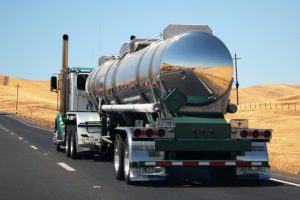There are nearly three million tractor-trailers in operation in the United States. Americans share the road with these massive vehicles which, when fully-loaded, can weigh twenty-five times the weight of a standard family car. When something goes wrong on the road and a tractor-trailer is involved, the consequences are far more likely to be serious – even deadly.

Fortunately, advances in safety features have been adopted to address many dangers posed by tractor-trailers. Widespread adoption and use of these systems helps make the road safer for everyone.
The best new safety features used in the trucking industry
Electronic stability control
Tractor-trailers are particularly top-heavy and unwieldy vehicles, prone to tipping or loss of traction. Electronic stability control (ESC) is designed to prevent a truck from jackknifing or tipping over.
 A stability control system is able to sense when a truck starts to slide or lose contact with the roadway. The system then reduces the throttle and automatically applies the brakes, helping the driver regain control. During a skid, the system can even apply individual levels of braking to each wheel of the vehicle, preventing a dangerous tip-over.
A stability control system is able to sense when a truck starts to slide or lose contact with the roadway. The system then reduces the throttle and automatically applies the brakes, helping the driver regain control. During a skid, the system can even apply individual levels of braking to each wheel of the vehicle, preventing a dangerous tip-over.
Lane departure systems
Lane departure warning systems use cameras and sensors to track lane lines and issue warnings when a tractor-trailer starts to steer out of a marked lane. These systems are well-suited for use by tractor-trailers, which typically drive well-marked highways for long periods. Lane departure warnings can help prevent drifting during long trips, but they are a specialized tool. A lane warning system will not help a driver deal with the many hazards and conditions that can be suddenly and unexpectedly encountered on the highway.
Additionally, some studies have raised concerns that lane-departure warning systems can give drivers a false sense of security, leading to decreased levels of attention on the road. No safety system is a substitute for a well-trained, attentive driver focused on their vehicle and their surroundings. However, the overall benefits of such systems are becoming increasingly clear.
Collision avoidance systems
A collision avoidance system applies the ideas of a lane departure system in a more comprehensive way. A system of radar, lasers, and cameras constantly tracks a vehicle’s surroundings, including the other vehicles on the road. If it senses an impending collision, the system can alert the driver or even apply the brakes.
The best collision avoidance systems track multiple objects all around the tractor-trailer in real time, as well as using G-force sensors, radar, and GPS to create a constantly updating map of the truck’s speed and position relative to any potential hazards. At their best, these systems can operate to reduce fatal crashes by 40% or more.
Ongoing adoption
Unfortunately, not all trucking companies have availed themselves of these new technologies and safety increases. Although some advanced safety features have become standard on new trucks, thousands of older vehicles continue to operate with only minimal precautions.
Sometimes, a truck’s only safety equipment may be that which is designed to deal with the aftermath of a crash or breakdown, such as fire extinguishers, reflective triangles, and wheel chocks. The Federal Motor Carrier Safety Administration does not even mandate that all trucks carry a first aid kit, although several states have adopted this requirement.
No amount of safety equipment, technology, or precautions can make a tractor-trailer completely safe. If you or someone you love has been involved in a collision with a tractor-trailer, it is vitally important that the truck and the trucking company’s safety record, procedures, and practices be assessed by an experienced attorney. Call the compassionate and knowledgeable trucking attorneys Allen & Allen for a free consultation, at 866-388-1307.





